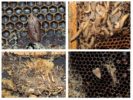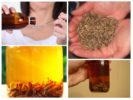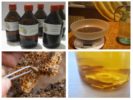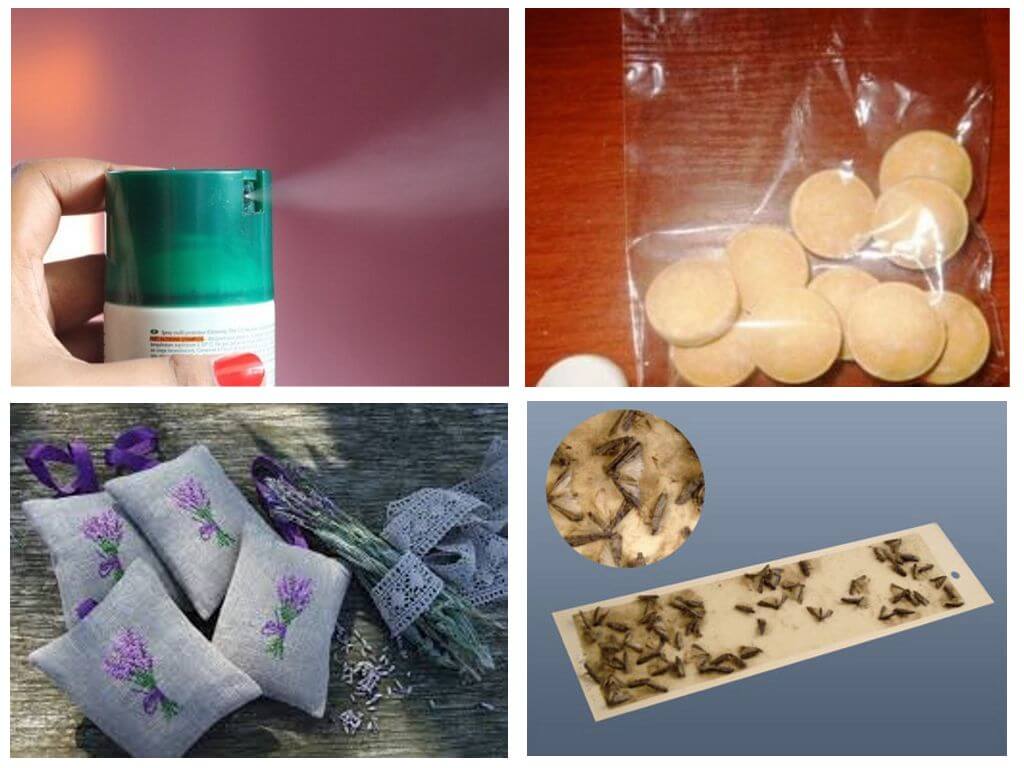- Wax moth
- Tincture of wax moth
- Allergy, heart disease, tuberculosis
- Application of tincture of wax moth
- Tincture of wax moth
Insect features
Wax moth is an unremarkable gray butterfly of a small size, which is considered a real thunderstorm of beekeeping. This winged pest of honey bees is familiar to every beekeeper. The insect has a smell very similar to a honey aroma. It is for this reason that the bees take wax moth for "their own", which gives it the opportunity to gain access to honey.
By itself, a plain-looking butterfly does not pose a danger to bees. It only lays eggs on a honeycomb, from which malicious larvae appear over time. At the initial stage, they feed on honey and bee bread, in the process of development - wax honeycombs mixed with the remains of the cocoon.
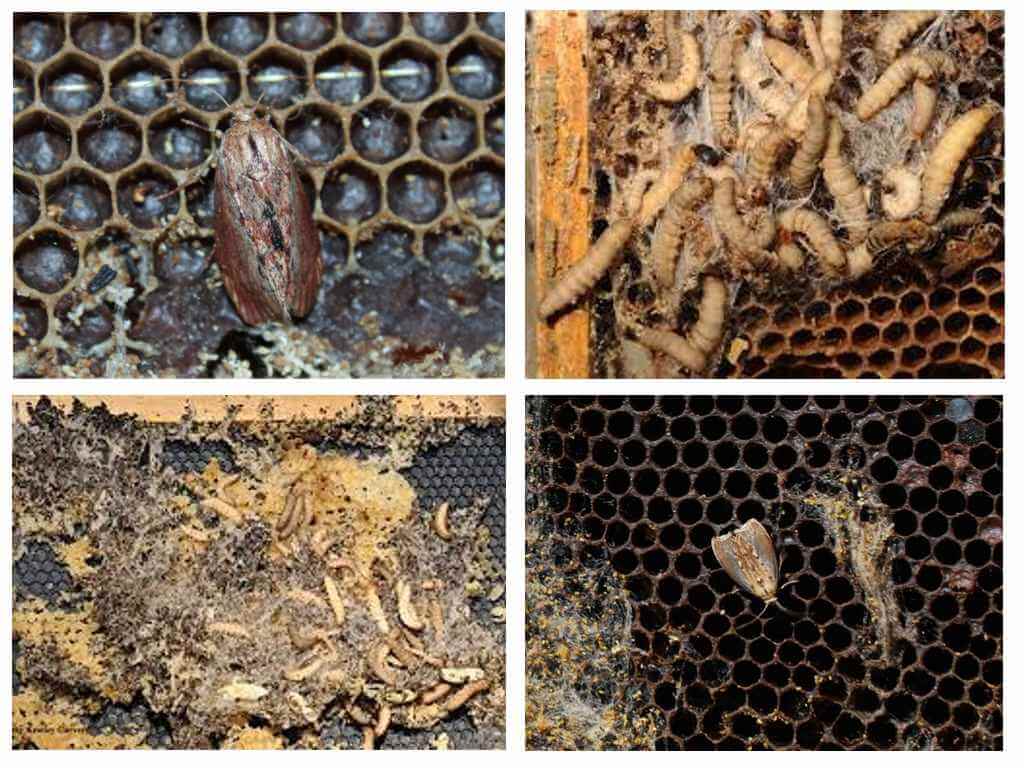
Eating wax, gluttonous caterpillars damage the honeycombs, covering the trajectory of their movement with silk. In addition, they eat honey and brood, as well as spoil the framework and insulation for hives. With a large accumulation of insects, caterpillars are able to eat even similar individuals. Such destruction affects bee families, as a result of which many die or leave their homes. But the caterpillars, due to their gluttony, transform into insects that are very useful from a medical point of view.
On a note
Bee Moth in Traditional Medicine used since ancient times. Our ancestors knew about the amazing healing properties of this insect back in the 17th century. Tincture of wax moth larvae was then used by healers to treat heart diseases.
Secrets of making tinctures of wax moth larvae
Tincture of wax moth (fire) is prepared from larvaewho have not yet reincarnated as pupae. The uniqueness of the organism of these creatures lies in the production of cerrase, a special enzyme, due to which beeswax is split and absorbed. That is why wax moth uses bee products for food.
On a note!
According to many beekeepers, for the preparation of tinctures, it is better to use larger larvae, since they contain a greater amount of nutrients. The recipe for making wax moth tincture is quite simple, which allows it to be done at home. To get 10% extract of wax moth larvae you will need 10 g of larvae per 100 ml of alcohol. The recipe for 20% of the tincture is characterized by a 2 times increased number of caterpillars.
The recipe for making wax moth tincture is quite simple, which allows it to be done at home. To obtain a 10% extract, you need 10 g of larvae per 100 ml of alcohol.The recipe for 20% of the tincture is characterized by a 2 times increased number of caterpillars.
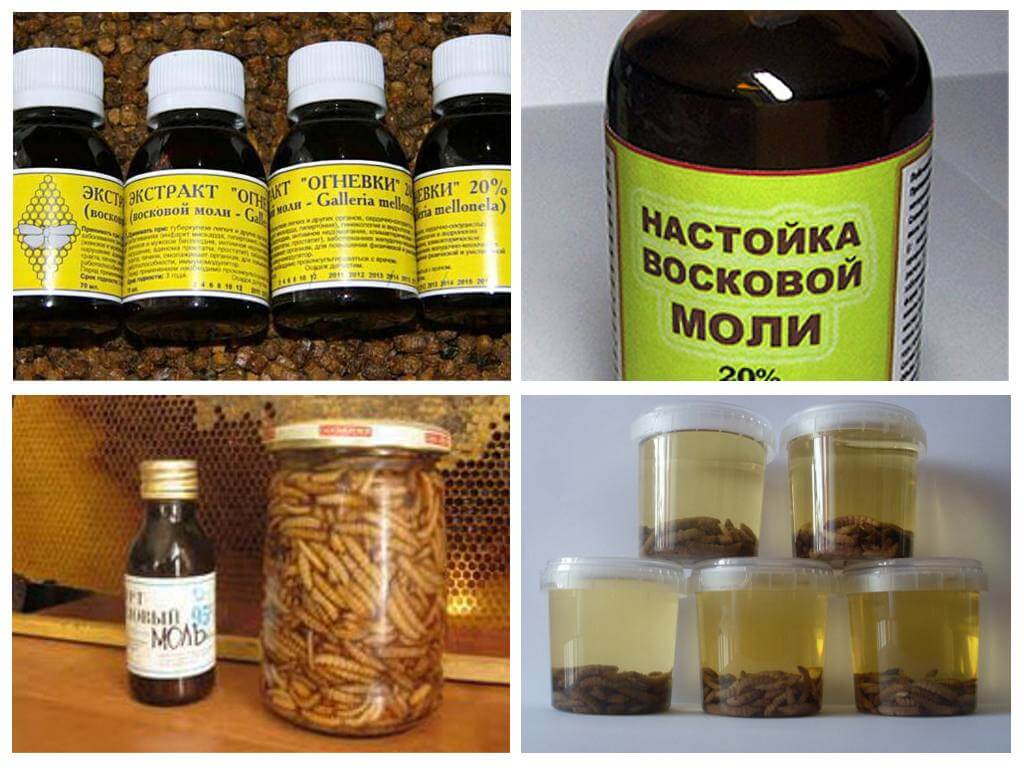
It is not difficult to prepare the tincture: these components must be placed in a glass container and insisted for a month in a cool and dark place. The light brown color of the medicine has a delicate honey-protein aroma. Before use, tincture must be filtered. The shelf life of such a medicine is up to 3 years.
The healing properties of tincture of wax moth larvae are explained by the chemical composition of the product. It contains:
- Vitamins and amino acids;
- Enzymes and lipids;
- Bioflavonoids and peptides;
- High molecular weight proteins and serotonin-like substances;
- Hypoxanthine;
- Nucleotides and steroid hormones;
- Fatty acids and minerals.
The use of tincture of wax moth has a wide spectrum of action due to the rich chemical composition of the alcohol extract.
Indications for use
Previously, traditional medicine experts recommended treatment with wax moth larvae to destroy tubercle bacillus. Later, such a method began to be used to treat:
- Diabetes mellitus;
- Oncological diseases;
- Varicose veins;
- The immune system (increases the body's resistance and helps increase physical activity);
- Acute respiratory infections, as well as bronchitis, pneumonia, pleurisy, tuberculosis;
- Allergies
- Cardiovascular diseases (arrhythmias, heart attack, angina pectoris, hypertension). The drug helps to reduce shortness of breath and lower blood pressure;
- With a pathology that is associated with a violation of metabolic processes;
- Diseases of the genitourinary system (especially wax moth treatment is effective for prostate adenoma).
And this is not all the indications that tincture of wax moth cures. It is also used in gynecology and surgery. The extract is also used in oncology, as it reduces the rate of spread of malignant tumors. The presence of psychotropic substances in the preparation helps to restore the nervous system: relieve fatigue, stress, tension, improve mood and memory.
Actively tincture of wax moth is also used by athletes during preparation for competitions in which large physical loads are provided. The drug also found application in hematology. It is prescribed for anemia and other blood diseases. Wax moth extract promotes wound healing and protects against fungal infections.
Feedback
“In the off-season and during the period of viral diseases, we take a tincture of wax moth with the whole family. The result of which is the absence of sick leave and school passes. Recommend."
Svetlana, Astrakhan
It is worth separately paying attention to the fact that traditional medicine does not recognize the effectiveness of tinctures from wax moth larvae, therefore, use the drug with caution. It is advisable to consult a doctor and not replace the medications prescribed by him with tincture alone.
Feedback
“As a doctor practicing for more than 10 years, I cannot confirm the miraculous properties of wax moth tinctures. Moreover, the replacement of potent drugs prescribed by a doctor for serious diseases is fraught with a worsening of the patient's condition. I do not recommend it to my patients instead of officially registered drugs that have been tested and confirmed their effect on the body. I explain the positive reviews about the tincture with the placebo effect. You need to trust traditional medicine, not healers or beekeepers! ”
Alexander Petrovich, St. Petersburg
Contraindications
Like any other medicine, in addition to the benefit, tincture from wax moth larvae can be harmful to human health. With special care, it should be taken by children, since the body of a small child is very sensitive.Contraindications to the use of tinctures of wax moth are as follows:
- Individual intolerance to beekeeping products, which may manifest as an allergic reaction, headache, weakness;
- Acute hepatitis;
- Allergy to bee products;
- Stomach ulcer (period of exacerbation);
- Chronic pancreatitis.
Some sources do not recommend taking the medicine for children under 14 years of age, pregnant and lactating women.
Mode of application
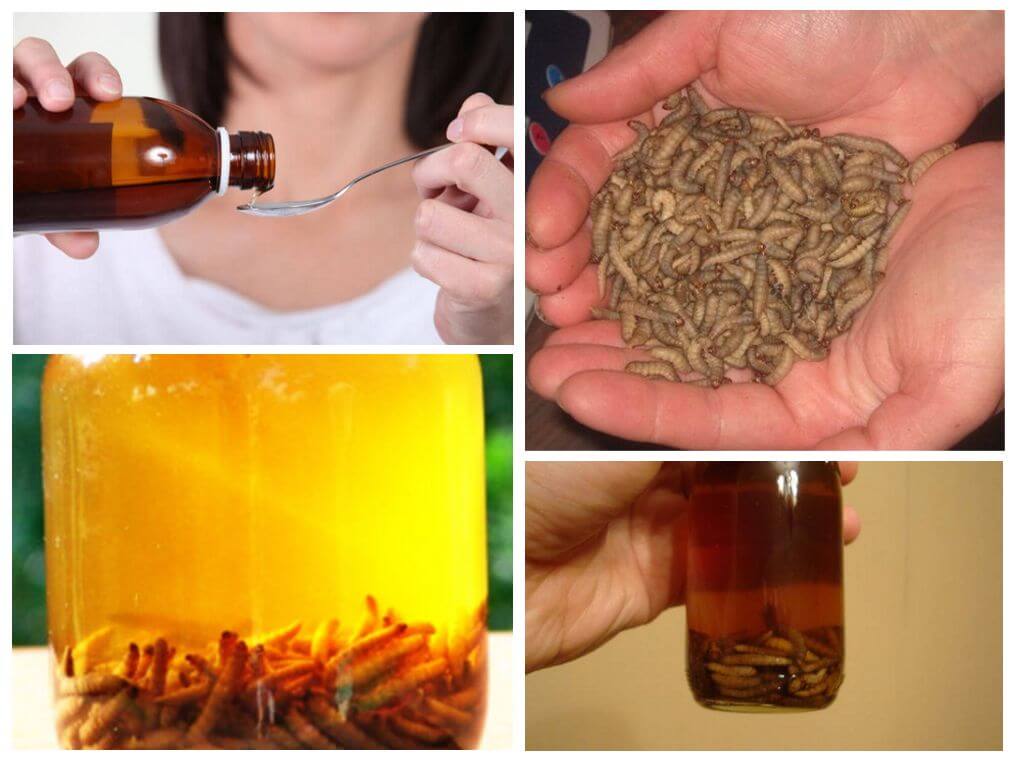
You need to know how to take a tincture of wax moth, as the dosage may vary. Instructions for use indicate how to drink, and how many days to take the drug for a specific disease. During treatment, it is not recommended to take alcohol and products that contain preservatives.
The course of treatment should be at least 3 months. This duration of therapy is explained by the need for the accumulation of useful substances, after which their potential is already being used.
Universal application
In most cases, a wax moth tincture is used for 15-20 drops of 10% extract (based on 3 drops per 10 kg of a person’s weight). The medicine is diluted with water or another liquid. A 20% solution is recommended to drink 7-10 drops 2 times a day. For preventive purposes, the intake of such a dose is made 1 time per day.
The duration of treatment depending on the disease may vary. To avoid doubtful moments, before using the drug, consultation and prescription of a doctor is necessary.
Outdoor application
Wax moth extract is often used for external application, as it has anti-inflammatory, analgesic, antiseptic, wound healing properties. Therefore, it is widely used to treat skin diseases, osteochondrosis, arthrosis, arthritis, thrombophlebitis. In addition, a cream or ointment based on an extract of wax moth larvae helps to eliminate pressure sores, bruises, sprains, and also wounds of various origins. An effective tincture for furunculosis, trophic ulcers, herpes.
Feedback
“I’ve been familiar with wax moth tincture for more than 10 years, since I cook it myself and am a beekeeper with experience. "This is an excellent tool, I am saving them from migraines, chest pains and colds."
Ivan Ilyich, Uralsk
Feedback
“I have heard about the healing properties of the fire for a long time. But you need to know how to properly take the tincture. After the first dose, red spots appeared on the body. I don’t know, maybe the remedy is simply not suitable for my body. ”
Lilia Ivanovna, Tambov
Feedback
“I learned about the many properties of tincture of wax moth from a friend. I decided to first try the product externally. I got rid of a terrible scar (4 cm in diameter) with the help of a muzzle. The skin surface in that place has become even, softer and noticeably whiter. ”
Elena, Chelyabinsk
According to reviews, the tincture of wax moth helped many patients get rid of migraines, gout, as well as many of the above diseases. However, in some patients, after discontinuation of the drug, unpleasant symptoms return again. There are also patients in whom taking the extract did not bring positive results, and even caused side effects in the form of allergies and headaches. In such cases, taking the drug is recommended to be canceled.
Where could I buy

Wax tincture is not produced or sold by any licensed pharmaceutical company. It is prepared by the beekeepers themselves or small private companies that specialize in selling beekeeping products.
Therefore, in order to avoid fraud and not harm your health, it is better to purchase the drug from familiar beekeepers. You can also use the Internet, and order the drug on the website of an economy that is interested in customers and takes care of its reputation.From shopping in online stores selling a variety of goods, it is better to refuse.
Feedback
"Tincture based wax moth For a long time I could not find anywhere. I searched all the pharmacies until a neighbor recommended a familiar beekeeper. I ordered the product from him. ”
Galina
Some companies involved in the production of tinctures do not provide instructions for use. The use of such drugs is of concern, since the dosage depends on the concentration of the solution. This is another nuance that you need to focus on when buying tinctures of wax moth.
